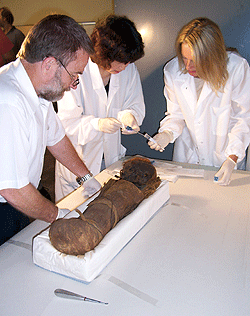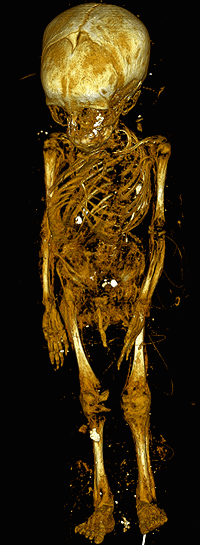Researchers at the University and elsewhere recently helped the Saint Louis Science Center probe the mysteries of a nearly 2,000-year-old baby mummy.
The mummy, part of the Science Center’s collection of artifacts for two decades, went on permanent public display March 15 in conjunction with the arrival of an IMAX film on mummies.

The niece of a St. Louis dentist donated the mummy to the Science Center in 1985. Her uncle purchased it during a trip to the Middle East around the beginning of the 20th century.
Parts of the mummy’s wrappings had been cut away, revealing the baby’s facial features, neck and chest. To learn more without inflicting further damage, Science Center officials turned to the Mallinckrodt Institute of Radiology at the School of Medicine.
Charles F. Hildebolt, D.D.S., Ph.D., associate professor of radiology, led a team that used X-ray computed tomography (CT) scanning to create 3-D images of the mummy, which allowed the researchers to virtually remove the mummy’s wrappings and peer inside the body.
Using data from the CT scans, Hildebolt and colleagues determined that the mummy was a boy. To assess his age at time of death, they looked at the development of his teeth, closure of the bones in his skull and the formation of his hands, all of which suggested that the boy was 7-8 months old when he died.

The scans showed extensive evidence of procedures often used in mummification. The boy’s brain, for example, had been removed through a break in his ethmoid bone, which separates the nasal cavity from the brain. His liver, stomach, lungs and intestines were removed from a cut in the abdomen.
“Generally, the heart was not removed during mummification because the Egyptians thought it was the seat of the soul,” Hildebolt said. “They believed the souls of the dead were able to reanimate their bodies in the hereafter.”
The scans produced no definitive evidence of what caused the boy’s early demise.
“Juvenile mortality was high at that point in world history, and it’s possible that whatever killed him left no trace on his bones,” Hildebolt said.
The baby was wrapped in an outer burial shroud and at least eight layers of linen bandages tied in place with linen bands.
To determine the time period from which the mummy came, scientists sent a postage-stamp-sized sample of the linen bandages to a radiocarbon-dating firm in Florida. The firm’s analysis found a 95 percent probability that the boy’s brief life occurred sometime between 40 B.C. and 130 A.D., likely during the time when Egypt was a province of the Roman Empire, Hildebolt said.
The CT scans also revealed a number of amulets placed throughout the body. Hildebolt said these charms and the superior quality of the mummification techniques suggest that the baby was from a middle-class family that could afford to pay for such services. Historians believe that when Egypt was a Roman province, both Egyptians and Romans may have had family members mummified.
Hildebolt obtained four tissue samples from different areas of the mummy and gave them to Anne Bowcock, Ph.D., professor of genetics, of medicine and of pediatrics, for analysis. Bowcock’s group was able to extract DNA from three of the samples and to sequence DNA from the mitochondria, energy-making structures in human cells thought to be descended from symbiotic bacteria. Mitochondria are passed on through the mother, and traits in the DNA suggested the baby’s mother might have been European and possibly Greek or Roman.
Bowcock plans further analysis to determine the geographic origin of the father by looking at the mummy’s Y chromosome.